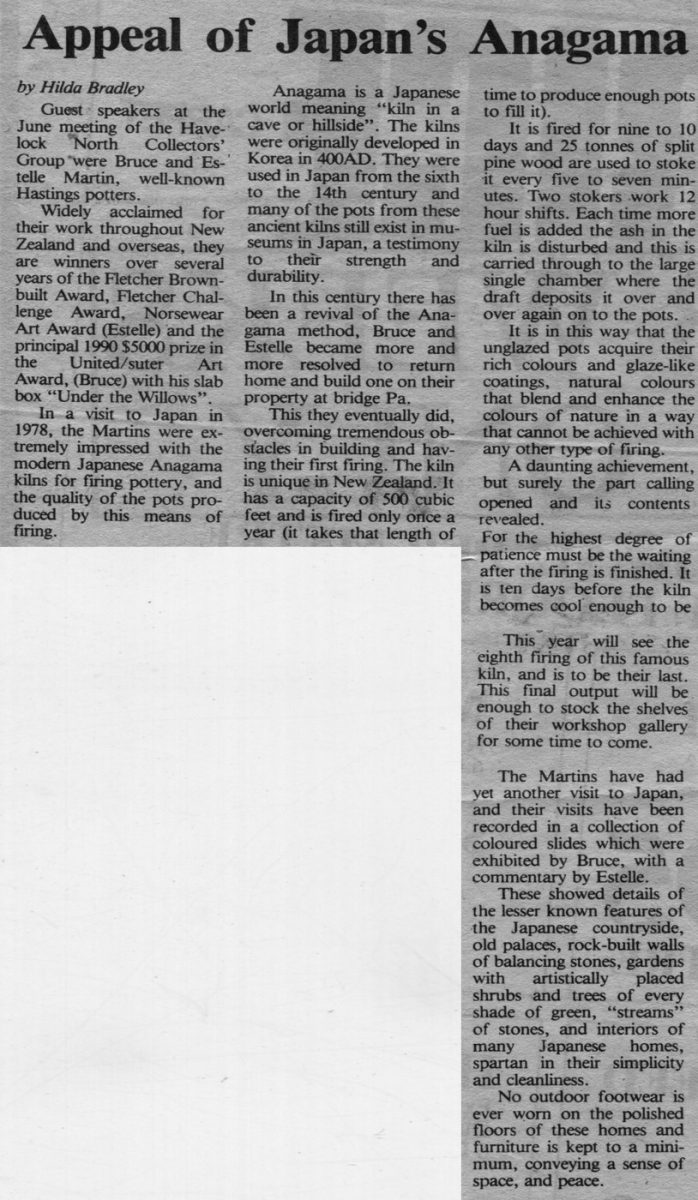Appeal of Japan’s Anagama
by Hilda Bradley
Guest speakers at the June meeting of the Havelock North Collectors’ Group were Bruce and Estelle Martin, well-known Hastings potters.
Widely acclaimed for their work throughout New Zealand and overseas, they are winners over several years of the Fletcher Brownbuilt Award, Fletcher Challenge Award, Norsewear Art Award (Estelle) and the principal 1990 $5000 prize in the United/suter [Suter] Art Award, (Bruce) with his slab box “Under the Willows”.
In a visit to Japan in 1978, the Martins were extremely impressed with the modern Japanese Anagama kilns for firing pottery, and the quality of the pots produced by this means of firing.
Anagama is a Japanese world [word] meaning “kiln in a cave or hillside”. The kilns were originally developed in Korea in 400AD. They were used in Japan from the sixth to the 14th century and many of the pots from these ancient kilns still exist in museums in Japan, a testimony to their strength and durability.
In this century there has been a revival of the Anagama method, Bruce and Estelle became more and more resolved to return home and build one on their property at bridge Pa.
This they eventually did, overcoming tremendous obstacles in building and having their first firing. The kiln is unique in New Zealand. It has a capacity of 500 cubic feet and is fired only once a year (it takes that length of time to produce enough pots to fill it).
It is fired for nine to 10 days and 25 tonnes of split pine wood are used to stoke it every five to seven minutes. Two stokers work 12 hour shifts. Each time more fuel is added the ash in the kiln is disturbed and this is carried through to the large single chamber where the draft deposits it over and over again on to the pots.
It is in this way that the unglazed pots acquire their rich colours and glaze-like coatings, natural colours that blend and enhance the colours of nature in a way that cannot be achieved with any other type of firing.
A daunting achievement, but surely the part calling [opened and its contents revealed.]???
For the highest degree of patience must be the waiting after the firing is finished. It is ten days before the kiln becomes cool enough to be [opened and the contents revealed.]
This year will see the eighth firing of this famous kiln, and is to be their last. This final output will be enough to stock the shelves of their workshop gallery for some time to come.
The Martins have had yet another visit to Japan, and their visits have been recorded in a collection of coloured slides which were exhibited by Bruce, with a commentary by Estelle.
These showed details of the lesser known features of the Japanese countryside, old palaces, rock-built walls of balancing stones, gardens with artistically placed shrubs and trees of every shade of green, “streams” of stones, and interiors of many Japanese homes, spartan in their simplicity and cleanliness.
No outdoor footwear is ever worn on the polished floors of these homes and furniture is kept to a minimum, conveying a sense of space, and peace.












Do you know something about this record?
Please note we cannot verify the accuracy of any information posted by the community.